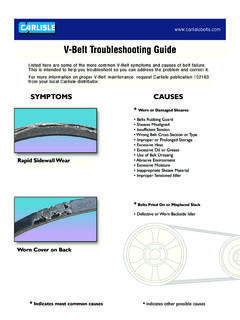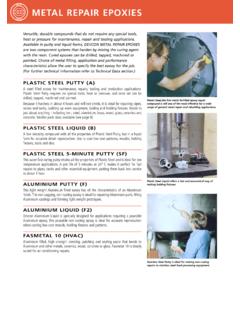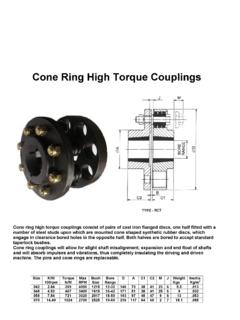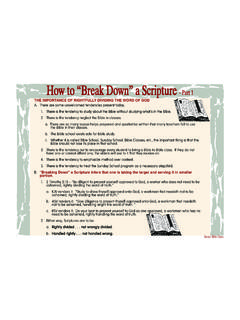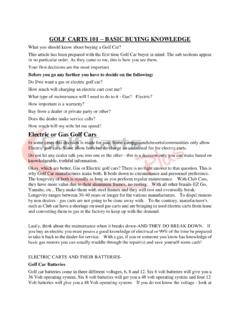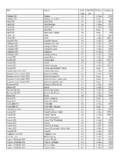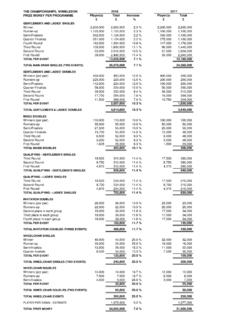Transcription of Conveyor Belt common problem trouble shooting …
1 Conveyor belt common problem trouble shooting guide 1. Excessive top cover wear over entire top surface or in load carrying area. A. The top cover quality is not adequate for the system/material being conveyed. Upgrade to a heavier top cover. Upgrade to a better cover compound. B. Off centre loading or improper loading of the belt . Make sure load chute places the load in the centre of the belt . Make sure the direction of the material down the chute is in the direction of the belt travel. C. Material build-up on the pulley faces of the return idlers, or on the Conveyor structure it's self. Clean system, improve material containment, install cleaners, check skirting, install belt scrapers after the head pulley.
2 D. Frozen, dirty, or misaligned return idlers. Clean rollers, properly align rollers, install cleaning devices at head pulley, use self cleaning rollers, improve maintenance (alignment, lubrication, and cleaning). E. Too much distance in between the idlers causing excessive material movement as the load travels up and over the idlers. Decrease the distance between idlers, increase tension if the belt is under tensioned. 2. Excessive pulley cover wear. A. Frozen idlers. Replace or repair frozen idlers. Improve maintenance of idlers (lubrication, cleaning, alignment). B. Insufficient traction between belt and drive pulley.
3 Make sure drive pulley is free of build up. Lag Drive pulley. Increase belt wrap on drive pulley. Increase belt tension if the belt is under tensioned. C. Material build-up on the pulley face or Conveyor structure. Clean system, improve material containment, install cleaners, check skirting, install belt scrapers in front of pulleys. D. Material is getting trapped between belt and pulleys. Improve containment at load point. Improve containment along the Conveyor . Install ploughs or scrapers in front of tail pulley. Practice good house keeping. E. Bolt heads from pulley lagging, or from slider bed material hold down on bare backs, are sticking up and catching the belt .
4 Inspect and replace or tighten as required. F. A condition of tilted or over tilted troughing idlers exists. Idler frames should be located per manufacturers recommendations, usually at 90 degrees to the belt and Conveyor frame. Align idlers per manufacturers recommendations. 3. Excessive edge wear. A. The belt is misaligned. Track and train belt . B. belt is coming in contact with the Conveyor frame and or hardware. Make sure belt is tracking properly. Make sure there is proper clearance between belt and any hardware. Make sure load is centred on belt . Clear any jammed material. Install training idlers on carry and return side of belt .
5 C. Off centre loading or improper loading of the belt . Make sure the load chute places the load in the centre of the belt . Make sure the direction of the material down the chute is in the direction of the belt travel. D. Material build-up on the pulley face or Conveyor structure. Clean system, improve material containment, install cleaners, check skirting, install belt scrapers in front of pulley. E. belt is cambered. Follow Legg Co. procedures for measuring camber. If the camber is less than 1/2%, the belt will train and run fine. If the camber is greater than 1/2%, the belt may need to be replaced.
6 F. If the edge wear occurs in the splice area, the splice may have been installed crooked. Re-splice belt . 4. belt runs off at the head pulley. A. Material build-up on the pulley face or Conveyor structure. Clean system, improve material containment, install cleaners, check skirting, install belt scrapers at head pulley. B. The pulleys and or the idlers are out of square with the belt centreline. Readjust pulleys and or idlers. C. Pulley lagging is worn or not adequate to produce sufficient traction. Replace with new or correct pulley lagging. D. Idler stands are not centred to the belt .
7 Readjust the stands for proper alignment. 5. belt runs off at tail pulley. A. The belt is running off centre as it comes around the tail pulley and/or through the load point. Re-track belt , install training idlers on the return prior to the tail pulley. B. Material build-up on the pulley face or Conveyor structure. Clean system, improve material containment, install cleaners, check skirting, install belt scrapers in front of pulley. C. The pulleys and or the idlers are out of square with the belt centreline. readjust pulleys and or idlers. D. Frozen, dirty, or misaligned return idlers. Clean rollers, properly align rollers, install cleaning devices at head pulley, use self cleaning rollers, improve maintenance (alignment, lubrication, and cleaning).
8 E. Inadequate belt tension is possible, recalculate tension requirements. If necessary increase weight on gravity take up or increase tension at screw take-up. 6. belt runs to one side for a considerable distance, or the entire Conveyor . A. The belt is running off centre as it comes around the tail pulley and/or through the load point. Re-track belt , install training idlers on the return prior to the tail pulley. B. Build up of material on idler rollers. Clean and maintain. Install scrapers, brushes, and other cleaning devices. C. Off centre loading or improper loading of the belt . Make sure load chute places load in the centre of the belt .
9 Make sure the direction of the material down the chute is in the direction of the belt travel. D. The pulleys and or the idlers are out of square with the belt centreline. Readjust pulleys and or idlers. E. Idler stands are not centred to the belt . Readjust the stands for proper alignment. F. The Conveyor frame is not square or the system is not properly supported. Straighten the frame in the affected area and check to make sure support in that area is correct. 7. belt slips when Conveyor is started. A. Insufficient traction between belt and drive pulley. Make sure drive pulley is free of build up.
10 Lag Drive pulley. Increase belt wrap on drive pulley. Increase belt tension. B. Inadequate belt tension is possible, recalculate tension requirements. If necessary increase weight on gravity take up or increase tension at screw take-up. C. Pulley lagging is worn or not adequate to produce sufficient traction. Replace with new or correct pulley lagging. D. Counter weight hitting bottom, not enough belt tension. Shorten belt and re-splice E. One or more of the system pulleys are below the acceptable diameter. Replace pulleys with diameters acceptable to belt requirements. F. Conveyor is overpowered.
